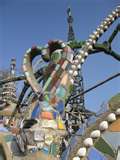Just a Second: a different way to look at time
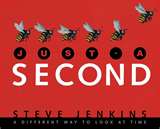 How many times do you think a hummingbird beats its wings in just one second? 10? 20? Steve Jenkins makes math irresistible in Just a Second: a different way to look at time. In one second, a hummingbird beats its wings 50 times. In one minute, a grizzly bear can charge one half-mile. Just a Second is full of information that fits well into units on time, measurement, and estimation, plus it’s visually captivating with Jenkins’ signature cut-paper art. His process in making the collages for his book is really cool, and you can see a video of how his books come together on his website: stevejenkinsbooks.com.
How many times do you think a hummingbird beats its wings in just one second? 10? 20? Steve Jenkins makes math irresistible in Just a Second: a different way to look at time. In one second, a hummingbird beats its wings 50 times. In one minute, a grizzly bear can charge one half-mile. Just a Second is full of information that fits well into units on time, measurement, and estimation, plus it’s visually captivating with Jenkins’ signature cut-paper art. His process in making the collages for his book is really cool, and you can see a video of how his books come together on his website: stevejenkinsbooks.com.
Before reading Just a Second, make some predictions with your students, like how many breaths do you think an adult takes in one hour? (900!) After reading the book and checking your predictions, make and test some new predictions about time. How many jumping jacks can you do in one minute? How long will it take you to flap your arms 50 times like a hummingbird? Can you sit perfectly still and quiet for a full minute? You can compare students’ results on charts or a graph. You can even make a pictograph of your classroom results, and let students make cool representations for themselves with cut-paper art. It may take a bit longer than “just a second”, but it will be time well spent.
Read MoreDream Something Big
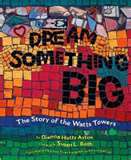 Dream Something Big: the Story of the Watts Towers, written by Dianna Hutts Aston with collages by Susan L. Roth, is a visually stunning biography of an artist you may never have heard of before. Simon Rodia was simply Uncle Sam to his neighbors in Los Angeles. Over 34 years, Sam built towers from broken bits of tile, glass, and cement that soar up to 99 feet high. His incredible recycled-art structures are now a National Landmark.
Dream Something Big: the Story of the Watts Towers, written by Dianna Hutts Aston with collages by Susan L. Roth, is a visually stunning biography of an artist you may never have heard of before. Simon Rodia was simply Uncle Sam to his neighbors in Los Angeles. Over 34 years, Sam built towers from broken bits of tile, glass, and cement that soar up to 99 feet high. His incredible recycled-art structures are now a National Landmark.
At the end of this gorgeously illustrated book you’ll find jaw-dropping photos of the Watts Towers. I’m including a close-up of the towers here so you can see the details as well as a photo that shows just how huge these works of art are. Share Dream Something Big with your students and do a fun math activity. Just how tall is a 99-foot tower? Get out the rulers and chalk and head to the playground or parking lot. Divide 99 by the number of students you have and let them take turns measuring and marking out each foot in 99 feet. Stand at one end of the length when you are done and imagine that distance soaring into the sky. Decorate the 99 feet with chalk “collages”, coloring bright shapes to resemble Sam’s art. Build your own towers with scrap materials, pipe cleaners, clay, etc. and encourage your students to “dream something big” like Sam did. For more inspiration, visit Dianna Hutts Aston’s website: diannahaston.com or Susan Roth’s website: susanlroth.com
Read MoreWe Will Miss You, Maurice Sendak
 May 8, 2012, the children’s book world lost an honored artist/author/illustrator, Maurice Sendak. Most people remember his book Where the Wild Things Are, but Sendak was by no means a one-hit wonder. He wrote and/or illustrated dozens of children’s books, so today, I’m mentioning a few of my favorites by the master from his 1962 collection, “The Nutshell Library”.
May 8, 2012, the children’s book world lost an honored artist/author/illustrator, Maurice Sendak. Most people remember his book Where the Wild Things Are, but Sendak was by no means a one-hit wonder. He wrote and/or illustrated dozens of children’s books, so today, I’m mentioning a few of my favorites by the master from his 1962 collection, “The Nutshell Library”.
Pierre: a cautionary tale in five chapters and a prologue is a favorite from my childhood. Pierre is so apathetic that he answers “I don’t care,” in any situation, even when a lion asks, “Then I’ll eat you, if I may.” Don’t worry, Pierre is fine when he’s shaken out of the lion by the doctor, and his close call with death has made him realize that he does care after all.
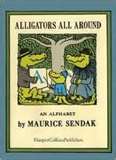 Alligators All Around is Sendak’s clever, alliterative alphabet book. It is short and snappy enough to keep the interest of the littlest ones, but the humorous art is sly enough for older kids as well:
Alligators All Around is Sendak’s clever, alliterative alphabet book. It is short and snappy enough to keep the interest of the littlest ones, but the humorous art is sly enough for older kids as well:
“A: alligators all around
B: bursting balloons
C: catching colds
D: doing dishes”
It’s a great writing prompt for a whole class or small group activity, writing two word alliterative phrases for each letter of the alphabet, choosing an A animal as the character to tie all the letters together.
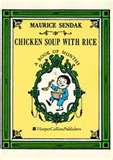 “Whoopy once
“Whoopy once
whoopy twice
whoopy chicken soup
with rice.”
I adore Chicken Soup with Rice: a book of months. I visited a first grade classroom where the teacher had a poster for each month with the verse by Sendak for children to illustrate. Every month has the repetition of (something) once, (something) twice, (something) chicken soup with rice, so even emerging readers can chime in with confidence.
The “Nutshell Library” books were set to music by Carole King. You can find the songs on her cd “Really Rosie”, and you can find the animated television special made in 1975 on VHS if you roll old school. I love how kids instantly spot the similarities of Pierre and the boy on the cover of Chicken Soup with Rice to Max from Where the Wild Things Are. Share some Sendak books with your kids and talk about the similarities and differences in the art and in the plots. Play the music from “Really Rosie” and let your students sing the “Nutshell Library” books so your students can be, to paraphrase Alligators All Around, “S: singing Sendak!”
Read More1 + 1 = a lot of laughs
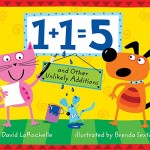 Any kindergartner at this time of year will quickly tell you that 1 + 1 = 2, unless it’s a kindergartner who has read this fantastic book 1 + 1 = 5 and Other Unlikely Additions by David LaRochelle and illustrated by Brenda Sexton. The lucky kid who’s read this book knows that 1 + 1 can = 3 if we’re talking about the horns of 1 unicorn + 1 goat. 1 + 1 = 5 if we’re talking about babies (1 set of twins + 1 set of triplets). When does 1 + 1 = hundreds? When we’re counting the seeds in 1 pumpkin + 1 watermelon, a task that would be fun to try with your class after reading this book. Each equation will get kids thinking of combinations of sets in new ways. Challenge your students to write their own 1 + 1 = stumper. Fold a piece of paper in half lengthwise (or hot-dog-wise if you visualize it that way). Set it up so the fold is on top, like a lift-the-flap. Have students write 1 + 1 = and their unexpected number. Lift the flap and show how 1 set of things + 1 set = the combination. Your students will have a ball stumping each other and their parents. 1 great book + 1 class of cool kids = plenty of learning for them and a lot of fun for you.
Any kindergartner at this time of year will quickly tell you that 1 + 1 = 2, unless it’s a kindergartner who has read this fantastic book 1 + 1 = 5 and Other Unlikely Additions by David LaRochelle and illustrated by Brenda Sexton. The lucky kid who’s read this book knows that 1 + 1 can = 3 if we’re talking about the horns of 1 unicorn + 1 goat. 1 + 1 = 5 if we’re talking about babies (1 set of twins + 1 set of triplets). When does 1 + 1 = hundreds? When we’re counting the seeds in 1 pumpkin + 1 watermelon, a task that would be fun to try with your class after reading this book. Each equation will get kids thinking of combinations of sets in new ways. Challenge your students to write their own 1 + 1 = stumper. Fold a piece of paper in half lengthwise (or hot-dog-wise if you visualize it that way). Set it up so the fold is on top, like a lift-the-flap. Have students write 1 + 1 = and their unexpected number. Lift the flap and show how 1 set of things + 1 set = the combination. Your students will have a ball stumping each other and their parents. 1 great book + 1 class of cool kids = plenty of learning for them and a lot of fun for you.




